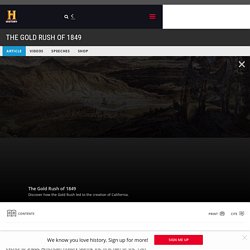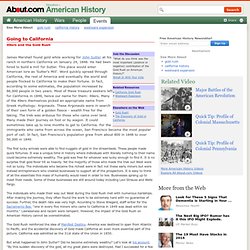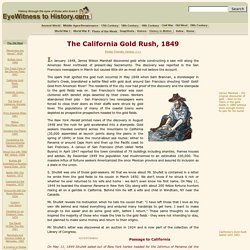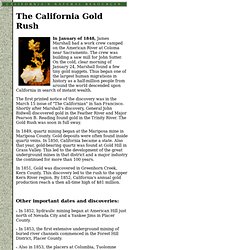

The Gold Rush of 1849 - Facts & Summary. Throughout 1849, people around the United States (mostly men) borrowed money, mortgaged their property or spent their life savings to make the arduous journey to California.

In pursuit of the kind of wealth they had never dreamed of, they left their families and hometowns; in turn, women left behind took on new responsibilities such as running farms or businesses and caring for their children alone. Thousands of would-be gold miners, known as ’49ers, traveled overland across the mountains or by sea, sailing to Panama or even around Cape Horn, the southernmost point of South America. By the end of the year, the non-native population of California was estimated at 100,000, (as compared with 20,000 at the end of 1848 and around 800 in March 1848).
To accommodate the needs of the ’49ers, gold mining towns had sprung up all over the region, complete with shops, saloons, brothels and other businesses seeking to make their own Gold Rush fortune. Going to California: 49ers and the Gold Rush. James Marshall found gold while working for John Sutter at his ranch in northern California on January 24, 1848.

He had been hired to build a mill for Sutter. This place would enter American lore as 'Sutter's Mill'. Word quickly spread through California, the rest of America and eventually the world and people flocked to California to make their fortune. In fact, according to some estimates, the population increased by 86,000 people in two years. Most of these treasure seekers left for California in 1849, hence our name for them: 49ers.
The first lucky arrivals were able to find nuggets of gold in the streambeds. The individuals who made their way out West during the Gold Rush met with numerous hardships. The Gold Rush reinforced the idea of Manifest Destiny. But what happened to John Sutter? The California Gold Rush, 1849. The California Gold Rush, 1849 In January 1848, James Wilson Marshall discovered gold while constructing a saw mill along the American River northeast of present-day Sacramento.

The discovery was reported in the San Francisco newspapers in March but caused little stir as most did not believe the account. The spark that ignited the gold rush occurred in May 1848 when Sam Brannan, a storekeeper in Sutter's Creek, brandished a bottle filled with gold dust around San Francisco shouting 'Gold! Gold! Gold from American River! ' the discovery and the stampede to the gold fields was on. The New York Herald printed news of the discovery in August 1848 and the rush for gold accelerated into a stampede. S. Mr. Mr. On May 11, 1849 Shufelt sailed out of New York harbor headed for the Isthmus of Panama (at the time a part of Columbia). "(We) proceeded up the river in canoes rowed by the natives, and enjoyed the scenery & howling of the monkeys & chattering of Parrots very much.
References: Mr. Lifornia's Natural Resources: A Brief History of the Gold Rush. In January of 1848, James Marshall had a work crew camped on the American River at Coloma near Sacramento.

The crew was building a saw mill for John Sutter. On the cold, clear morning of January 24, Marshall found a few tiny gold nuggets. Thus began one of the largest human migrations in history as a half-million people from around the world descended upon California in search of instant wealth. The first printed notice of the discovery was in the March 15 issue of "The Californian" in San Francisco. Shortly after Marshall's discovery, General John Bidwell discovered gold in the Feather River and Major Pearson B. In 1849, quartz mining began at the Mariposa mine in Mariposa County. In 1851, Gold was discovered in Greenhorn Creek, Kern County. Other important dates and discoveries: In 1852, hydraulic mining began at American Hill just north of Nevada City and a Yankee Jims in Placer County.
Also in 1853, the placers at Columbia, Tuolomne County, began to yield vast amounts of gold. The California Gold Rush (1848 to 1859) Gold Rush! California's Untold Stories, Oakland Museum of California.